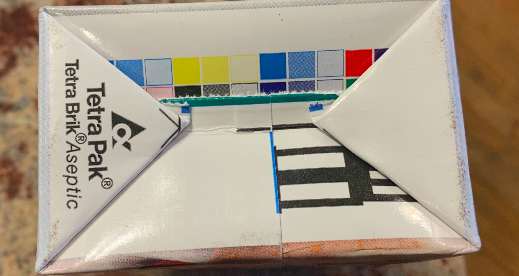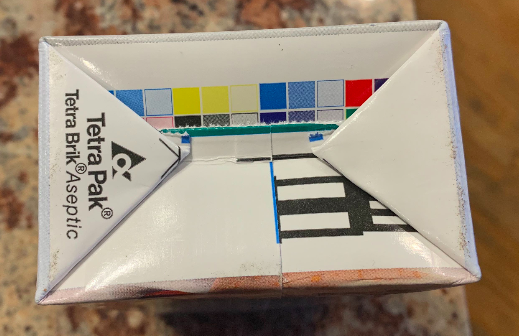Why Are There Random Colored Squares on My Box of Almond Milk?

Food packaging has a lot of information on it. There’s the product’s name, the ingredients, nutritional information, and … a lot of other stuff, which you probably gloss over. Which is why you may have never noticed the rainbow of squares like the one seen below.

That picture is a flipped-over box of almond milk, placed on my kitchen counter. I apologize for the photo being a bit crooked; I’m not that good with the phone camera. But it does the job. Clear as day, on the part of the box you probably never bother to look at, is a sea of squares of all different colors. And this isn’t unique to almond milk. I spent a few minutes yesterday looking for more examples in my kitchen and came across a handful more: on the inside flap of a box of mini pizzas, on a bag of bread, on a box of cereal, and on a case of Diet Snapple. You can check out those photos here — all different takes on the same idea.
If you’ve never noticed these constellations of colors., or if you’ve been ignoring them, don’t worry. These marks have nothing to do with what’s in your food. They’re more like an ingredients list for the packaging itself.
The color patches are called “printer’s color blocks” (or sometimes “process control patches”). When printing in color — and yes, this includes the art and copy on food packaging — we use a mix of four base colors: cyan, magenta, yellow, and black. This quartet, known collectively as the CMYK color model, can be used to create millions of different hues. If one of those four ink levels is out of balance, the whole print run will suffer. Catching that is easy — but fixing it is tricky because you don’t necessarily know which of the four colors is off. The blocks take care of that. Bridget Christenson, a public relations manager for General Mills, explained how to Slate:
The blocks provide very technical information about printing conditions that allow printers to quickly adjust. For example, if something looks too red, the color blocks can help to determine if it’s the Yellow that is too weak or if it’s the Magenta that is too heavy. This keeps printing quality high.
As the packaging comes off the printer, quality control workers (and increasingly, machines) check to make sure everything looks right. If something is off, a quick look at the field of colored boxes will help them fix it, and fast.
That said, you may not see this feature on a lot of the products in your house. According to Mental Floss, “the decision to include this element is an option, not a rule” and “some companies also crop off the color blocks during the packaging process.” And sometimes, the boxes are hidden under flaps or, in the case of my almond milk, on the side you don’t want to look at if you want to avoid a big spill.
Bonus fact: The CMYK color model gets its name from the colors used — C for cyan, M for magenta, and Y for yellow. The K, though, doesn’t stand for “black.” It stands for “key.” In printing, the lines and many of the details are printed in black ink using something called a “key plate,” as the colored inks aren’t good for developing detail. The K is a reference to that use.
From the Archives: The Case of the Missing Magenta: Why isn’t magenta (or pink) in the rainbow?
